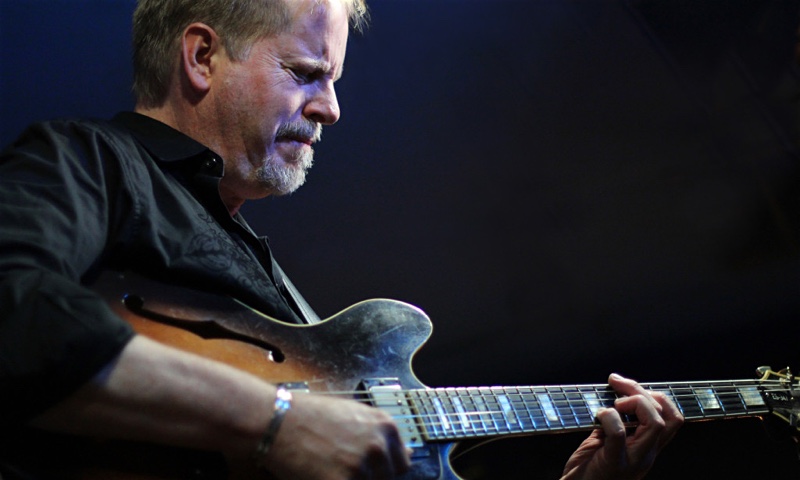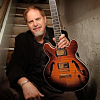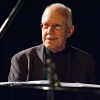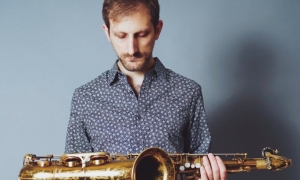Home » Jazz Articles » Interview » Dave Stryker: Soulful Sound
Dave Stryker: Soulful Sound

They hear your feel before they hear your notes. So if you have a good feel, and it hits people in their heart, then you're doing the right thing.
—Dave Stryker
"I started in '1986," he says. "I was there '86 to '96 and then I left for a little while. Then I came back with him the last year he was alive."
By then it was 2000. "He started to call me and I would do some New York gigs. Then I did a little tour of the west coast. We came back and were doing the Blue Note. Everything was going great. He sounded great." The saxophonist bid goodnight to his cohorts. The next afternoon in the hotel he suffered a heart attack. "We all showed up at the gig Sunday night and there was no Stanley."
Stryker's fond experiences with the renowned saxman were the basis of his recent tribute CD, Messin' With Mr. T, a hard-hitting gem that calls on some of the best saxophonists in the business to interpret music associated with Turrentine—a different one on each of the ten tunes. The music is joyous and ballsy, successfully conjuring up Turrentine's vibe. It includes "'La Place Street," the last song Turrentine played on his last gig and also the name of the street he grew up on in Pittsburgh. The CD rose to the top of the jazz charts in 2015.
If that weren't enough—and it never is for Stryker, who marked his 26th recording as a leader with Mr. T—the guitarist revisited his longstanding association with saxophonist Steve Slagle this year with the new CD Routes, done with an expanded band that has three horns melding with the quartet. That recording, by necessary intent, explores different territory, moving from steady swing, to more aggressive and angular territory ("Nothin' Wrong With It"), to serene ("Great Plains") to funky groove ("Lickety Split Lounge"). All of that music is penned by Slagle or Stryker, save for one Charles Mingus tune ("Self-Portrait in Three Colors").
To have diverse projects is not new for Stryker, whose chops can handle anything from soul to more outlandish music inspired by the likes of John Coltrane. Not only does he have the physical means to dazzle his instrument, but he has a big, warm sound that further entices the listener. He plays with feeling, not just dexterity.
"I think that's what we like about jazz is the improvisation of it and composing on the spot," says Stryker. "The longer you do it and the better you get, you're making up new melodies, not just rehashing licks. To play the music, you have to learn the language, but once you learn the language, you get past that to the next level, where you're making melodies. It's exciting."
"Also having a good feel so when people hear you" is a key, he says. "The first thing they hear is your sound and they hear your feel before they hear your notes. So if you have a good feel, and it hits people in their heart, then you're doing the right thing. That's what music should do: make you feel good."
That's what Stryker accomplishes whether with his organ trio, his partnership with Slagle or appearing with others. It's a lesson that was re-enforced working with the likes of McDuff and Turrentine. Both influences pop up. Even his association with Slagle has its beginning in McDuff's band. The CD title Routes, has the double meaning of describing the routes the two players have taken and how those paths have crossed, and also the roots of their music, which have similarities.
Stryker went to New York in 1980 and his first big-time job was with the organist. "McDuff had told me if I ever get to New York, to look him up. So I went up there and auditioned with him. Steve Slagle was in the band, so there's a lot of paths crossing there. When I was with McDuff, we played a steady gig up in Harlem at a place called Dude's Lounge. A lot of guys would come in there. Jimmy Smith and George Benson, Lou Donaldson and Stanley Turrentine. That's where I first met Stanley. When his guitarist couldn't make it, I went. Stanley offered me the gig."
He recalls, "They both played with a lot of feeling. A lot of soul. You had to have that blues underpinning. For a young guy to have that opportunity to play, first of all, with Jack... he had all my favorite guitar players in his band. Grant Green, Pat Martino, George Benson. That was a validation. Then of course, we all love Stanley. He just was super soulful. Great time. Great feel. If you're following one of his solos, your game's got to be on top, otherwise it's going to be pretty sad. You're not going to last very long. It was that kind of standard. The bar was set high. You had to play with feeling and soul and good time."
The venues always had good crowds, says Stryker. "He knew how to play music that was challenging, but it was accessible. People dug it. Whenever we would play, he'd have his fans and there were a lot of people there. The way he would program a set. Those kind of lessons were great ... Any musician knows Stanley was a formidable saxophonist."
Before the Turrentine tribute, Stryker started his own label, Strikezone, and his recording Eight Track did well.
"I wanted to follow it up and keep the momentum going," he says. The idea of a Turrentine tribute had been on his mind for some time. When he decided to push forward with it, he selected songs Turrentine would play in a set list every night. He decided it would be more interesting to use different players, rather than one person burdened with interpreting the material throughout the entire CD. He enlisted monsters like Chris Potter, Eric Alexander, Don Braden, Javon Jackson, Houston Person, Slagle and even Jimmy Heath.
"I basically used guys I knew. Friends of mine, but who I would have actually seen at gigs. When I was with Stanley I would see Javon Jackson or Eric Alexander. I would see a lot of these guys at the bar when we were playing. So I knew they were deep into Stanley. Everybody I called was immediately on board. Any saxophonist loves Stanley. So I was fortunate to get all the great sax players that I did get."
He only met Heath last year, when he was asked to play on the album Heath was doing with singer Roberta Gambarini, Connecting Spirits. Turrentine would often play "In a Sentimental Mood" as his ballad during a set, and Heath agreed to do it for the album. "I was honored."
Routes deals with Stryker's relationship with Slagle. "We started playing together in the early '80s. We both did our own projects through the years. About 10 or 15 years ago, we started to call it the Stryker-Slagle band. We've done about five records with that group."
The CD has Bill O'Connell on piano and an unusual array of horns added to the mix—John Clark on French horn, Clark Gayton on tuba and trombone and Billy Drews on tenor sax and bass clarinet. "Some of the tunes are evocative of where Steve grew up in Los Angeles. I have one on there called 'Great Plains,' because I'm from the midwest.
In Omaha, Nebraska, where Stryker was raised, he was listening to like Albert King, B.B. King and got into the Allman Brothers. His soul started there. "But also, it's something you have or you don't. You feel it in your soul. Music comes from your heart. You've got that grounded in your playing, which all the greats that I like do. It permeates whatever you do. It's a feeling that's in there," he says.
In Omaha, Stryker took guitar lessons, but never attended music school. "I listened to the records and I did gigs. That's how I learned how to play. That's a good foundation to have—learning that old-school way." He started his relationship with the organ, playing with John Maller. "He was into Jimmy Smith. Every town has great unknown players wherever you go. I was lucky to have a couple of the older guys take me under their wing. At jam sessions, they weren't afraid to take me by my coattails and tell me what I needed to do."
His sound and feeling "was probably solidified once I got the gig with Jack McDuff and then Stanley Turrentine. You had to have some kind of soul in your playing. Otherwise you wouldn't last very long. I had that in there before I even got with those guys, but then once I spent all the years on the road with those cats, it really seeped in," says Stryker. "I feel like I have taken that and put a new standard upon it. A lot of times I stretch it out and do more advanced harmonic ideas. I got way into Coltrane and all these guys. And of course all the great guitar players. That's how I learned how to play, by listening to Wes Montgomery, Jim Hall, Grant Green, Pat Martino, George Benson. All those guys."
From Maller to McDuff and beyond, Stryker has had a fondness for the Hammond B3 and still plays with Jared Gold, a remarkable organ player.
"It's a classic sound. From Jimmy Smith, who's the world champ of that, to guys like Larry Young. I really got into those records with Elvin Jones and Grant Green, the trio they had. It's a sound that melds with the guitar really beautifully. You've got the bass lines with the left hand and feet. So when the organist is soloing, it leaves the harmony and the chords up to the guitar. Whereas if you're playing in a piano situation, it's a different approach, because the chords are already being stated by the piano in his left hand. With an organ, because he's kicking the bass—he only has to hands. A lot of people have the misconception that the bass is only the feet, but actually the bass line in the organ is in the left hand, with accents on the pedals with the feet. Except where you're doing slower tempos or ballads. Then it's different ... It feels great. It just swings like nothing else. Even the great bass players I know get jealous sometimes because it just swings so hard. You can't deny it."
For a time he didn't use organ in his projects, though he played on a record each with Joey DeFrancesco and Larry Goldings. "I felt like I'd already done that," he notes. But about 12 years ago a club opened up near his West Orange, N.J. home. Cecil's was owned and operated by drummer Cecil Brooks III and they hosted jam sessions. It was at Cecil's where he met Gold. That brought him back to the guitar-organ sound. "Once I started playing with Jared about 10 years ago, he's been my go-to guy. Sometimes we'll add vibes. Or a saxophonist... It's a big sound with three people. You damn near sound like a big band sometimes. But you can also be as subtle as you want with it, as Larry Young showed us. You can be harmonically modern and cool."
Stryker was in New York for a few years before landing the McDuff gig, playing in a lot of sessions around town and hustling up gigs. In 1988, he recorded his first record, First Strike, on a Japanese label. In 1990, he went to SteepleChase Records, the first being Strike Zone, which included Slagle in the band. "We did about one record a year for at least 20 years. So I've been fortunate to document a lot of my ideas. Done everything from big band to my Blue to the Bone band with four horns that focuses more on the bluesier side of my playing," he says. "I've done everything. It's been great."
In addition to running his Strikezone label, he teaches guitar at Indiana University in an arrangement that allows him to commute a couple times a month for teaching, which gives him time to tour and perform.
"I'm keeping busy and happy to be busy," Stryker says. "There's a lot of healthy competition, as there should be. I've been paying my dues a long time. I'm happy to see young cats come along and I'm happy to help. I feel like I'm part of the last generation of guys that got to play with some of these masters. I got the experience of being on the road and paying those dues in a van with McDuff. Flying all over the world and playing tons of gigs with Stanley. With Stanley, I got to play with Jimmy Smith, Freddie Hubbard, Dizzy Gillespie. If there's anything I can help pass along to the next generation, I'm happy to do."
Meanwhile, he continues to please audiences and record buyers with his sweet sound, crisp chops and his restless creativity.
"One thing I learned from Stanley and Jack McDuff is, you play something people recognize, even if it's a pop tune, but it's done in a hip way—which is what I did in the Eight Track record—people really dig it," he says. "It's a song they know. They're hearing it in a different way. It's a way to bring people into the music. Stanley dd that and Jack did that. It's been going on for a long time. It's nothing new."
And the improvisational aspect still a joy and challenge. It's the flame that has been attracting jazz moths for decades. "It's hard to explain. The improvisation part of jazz is so unknown," he says. "You're inventing something new. Trying, in the moment, to create something new every time. Whether you're doing a standard tune or an original or a revamped pop tune, when you're improvising you're trying to come up with your own melodies over it. It's not worked out. So it's always fresh. Out of that comes that excitement of, 'What's going to happen?'"
Photo credit: Chris Drukker
Tags
Dave Stryker
Interview
R.J. DeLuke
Jim Eigo, Jazz Promo Services
United States
New York
New York City
Grant Green
Wes Montgomery
Pat Martino
Jack McDuff
Stanley Turrentine
Pittsburgh
Steve Slagle
Charles Mingus
John Coltrane
Jimmy Smith
george benson
Lou Donaldson
Chris Potter
Eric Alexander
Don Braden
Javon Jackson
Houston Person
Jimmy Heath
Roberta Gambarini
Bill O'Connell
Los Angeles
albert king
B.B. King
Jim Hall
Jared Gold
Larry Young
Elvin Jones
Joey DeFrancesco
Larry Goldings
Freddie Hubbard
Dizzy Gillespie
PREVIOUS / NEXT
Dave Stryker Concerts
Support All About Jazz
 All About Jazz has been a pillar of jazz since 1995, championing it as an art form and, more importantly, supporting the musicians who make it. Our enduring commitment has made "AAJ" one of the most culturally important websites of its kind, read by hundreds of thousands of fans, musicians and industry figures every month.
All About Jazz has been a pillar of jazz since 1995, championing it as an art form and, more importantly, supporting the musicians who make it. Our enduring commitment has made "AAJ" one of the most culturally important websites of its kind, read by hundreds of thousands of fans, musicians and industry figures every month.






















